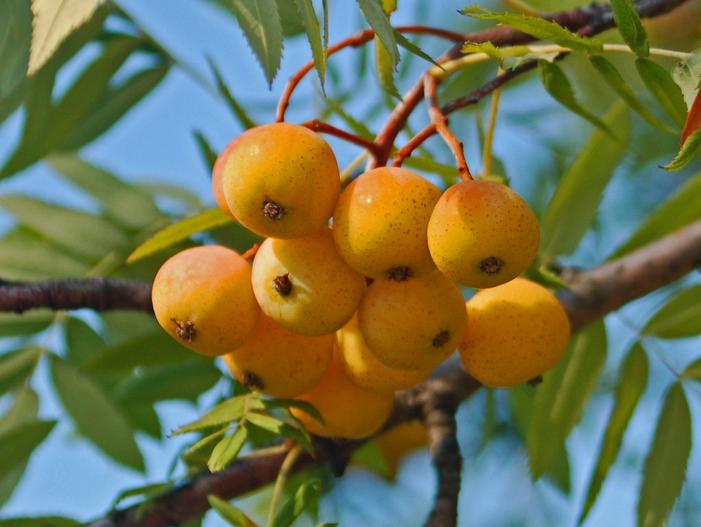Service Tree
(Sorbus domestica)
Service Tree (Sorbus domestica)
/
/

Ettore Balocchi
CC BY 2.0
Image By:
Ettore Balocchi
Recorded By:
Copyright:
CC BY 2.0
Copyright Notice:
Photo by: Ettore Balocchi | License Type: CC BY 2.0 | License URL: https://creativecommons.org/licenses/by/2.0/ | Uploader: Ettore Balocchi | Publisher: Flickr





















































Estimated Native Range
Summary
Sorbus domestica, commonly known as the Service Tree or Sorb Tree, is a deciduous tree or shrub native to a variety of habitats including woodlands, forest edges, and rocky hillsides across Europe, from the Mediterranean to the Caucasus. It typically grows to 15–20 meters tall with a trunk up to 1 meter in diameter, but in harsher, exposed conditions it may be a smaller shrub 2–3 meters tall. The bark is brown and smooth in young trees, becoming fissured and flaky with age. The winter buds are green and coated with a sticky resin. The Service Tree blooms in late spring, producing flowers that are 13–18 mm in diameter with five white petals and 20 creamy-white stamens, which are moderately showy. The fruit, resembling small apples, matures in late autumn and is used in Europe to make a cider-like drink. When freshly picked, the fruit is astringent and gritty, but after bletting, it becomes sweet and palatable.
The Service Tree is valued for its ornamental qualities, including its attractive flowers and foliage, as well as its unique fruit which has culinary uses. It is suitable for large gardens and parks, often used as a specimen tree. It adapts to a range of soil types, provided they have good drainage, and prefers full sun to light shade. While it is not commonly found in cultivation, it can be a low-maintenance choice for suitable climates. There are no major disease problems, but fire blight can occasionally be an issue. The tree is not known for aggressive roots or invasiveness.CC BY-SA 4.0
The Service Tree is valued for its ornamental qualities, including its attractive flowers and foliage, as well as its unique fruit which has culinary uses. It is suitable for large gardens and parks, often used as a specimen tree. It adapts to a range of soil types, provided they have good drainage, and prefers full sun to light shade. While it is not commonly found in cultivation, it can be a low-maintenance choice for suitable climates. There are no major disease problems, but fire blight can occasionally be an issue. The tree is not known for aggressive roots or invasiveness.CC BY-SA 4.0
Plant Description
- Plant Type: Tree
- Height: 10-12 feet
- Width: 3-4 feet
- Growth Rate: Moderate
- Flower Color: White
- Flowering Season: Spring, Summer
- Leaf Retention: Deciduous
Growth Requirements
- Sun: Full Sun
- Water: Medium
- Drainage: Slow, Medium, Fast
Common Uses
Bird Garden, Butterfly Garden, Edible*Disclaimer: Easyscape's listed plant edibility is for informational use. Always verify the safety and proper identification of any plant before consumption., Fragrant, Low Maintenance, Salt Tolerant
Natural Habitat
Woodlands, forest edges, and rocky hillsides across Europe
Other Names
Common Names: Speierling
Scientific Names: , Sorbus domestica, Cormus domestica, Pyrus sorbus, Crataegus austera, Malus sorbus, Prunus sorbus, Pyrenia sorbus, Sorbus domestica var. obtuini, Sorbus syrmiensis,
GBIF Accepted Name: Cormus domestica (L.) Spach